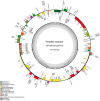The Complete Chloroplast Genome Sequences of the Medicinal Plant Forsythia suspensa (Oleaceae)
- PMID: 29088105
- PMCID: PMC5713258
- DOI: 10.3390/ijms18112288
The Complete Chloroplast Genome Sequences of the Medicinal Plant Forsythia suspensa (Oleaceae)
Abstract
Forsythia suspensa is an important medicinal plant and traditionally applied for the treatment of inflammation, pyrexia, gonorrhea, diabetes, and so on. However, there is limited sequence and genomic information available for F. suspensa. Here, we produced the complete chloroplast genomes of F. suspensa using Illumina sequencing technology. F. suspensa is the first sequenced member within the genus Forsythia (Oleaceae). The gene order and organization of the chloroplast genome of F. suspensa are similar to other Oleaceae chloroplast genomes. The F. suspensa chloroplast genome is 156,404 bp in length, exhibits a conserved quadripartite structure with a large single-copy (LSC; 87,159 bp) region, and a small single-copy (SSC; 17,811 bp) region interspersed between inverted repeat (IRa/b; 25,717 bp) regions. A total of 114 unique genes were annotated, including 80 protein-coding genes, 30 tRNA, and four rRNA. The low GC content (37.8%) and codon usage bias for A- or T-ending codons may largely affect gene codon usage. Sequence analysis identified a total of 26 forward repeats, 23 palindrome repeats with lengths >30 bp (identity > 90%), and 54 simple sequence repeats (SSRs) with an average rate of 0.35 SSRs/kb. We predicted 52 RNA editing sites in the chloroplast of F. suspensa, all for C-to-U transitions. IR expansion or contraction and the divergent regions were analyzed among several species including the reported F. suspensa in this study. Phylogenetic analysis based on whole-plastome revealed that F. suspensa, as a member of the Oleaceae family, diverged relatively early from Lamiales. This study will contribute to strengthening medicinal resource conservation, molecular phylogenetic, and genetic engineering research investigations of this species.
Keywords: Forsythia suspensa; chloroplast genome; comparative genomics; phylogenetic analysis; sequencing.
Conflict of interest statement
The authors declare no conflict of interest.
Figures




Similar articles
-
Assembly and analysis of the complete mitochondrial genome of Forsythia suspensa (Thunb.) Vahl.BMC Genomics. 2023 Nov 23;24(1):708. doi: 10.1186/s12864-023-09821-4. BMC Genomics. 2023. PMID: 37996801 Free PMC article.
-
[Intraspecific variation of Forsythia suspensa chloroplast genome].Zhongguo Zhong Yao Za Zhi. 2025 Apr;50(8):2108-2115. doi: 10.19540/j.cnki.cjcmm.20250114.103. Zhongguo Zhong Yao Za Zhi. 2025. PMID: 40461220 Chinese.
-
The complete chloroplast genome sequence of the medicinal plant Salvia miltiorrhiza.PLoS One. 2013;8(2):e57607. doi: 10.1371/journal.pone.0057607. Epub 2013 Feb 27. PLoS One. 2013. PMID: 23460883 Free PMC article.
-
[Establishment and application of chloroplast genome database with the largest number of species in world].Zhongguo Zhong Yao Za Zhi. 2024 Dec;49(23):6257-6263. doi: 10.19540/j.cnki.cjcmm.20240909.101. Zhongguo Zhong Yao Za Zhi. 2024. PMID: 39805772 Review. Chinese.
-
The Biological Effects of Forsythia Leaves Containing the Cyclic AMP Phosphodiesterase 4 Inhibitor Phillyrin.Molecules. 2021 Apr 19;26(8):2362. doi: 10.3390/molecules26082362. Molecules. 2021. PMID: 33921630 Free PMC article. Review.
Cited by
-
Comparative analysis of chloroplast genomes reveals phylogenetic relationships and intraspecific variation in the medicinal plant Isodon rubescens.PLoS One. 2022 Apr 6;17(4):e0266546. doi: 10.1371/journal.pone.0266546. eCollection 2022. PLoS One. 2022. PMID: 35385539 Free PMC article.
-
Comparative Genomics, Phylogenetics, Biogeography, and Effects of Climate Change on Toddalia asiatica (L.) Lam. (Rutaceae) from Africa and Asia.Plants (Basel). 2022 Jan 17;11(2):231. doi: 10.3390/plants11020231. Plants (Basel). 2022. PMID: 35050119 Free PMC article.
-
Chloroplast Genome of the Folk Medicine and Vegetable Plant Talinum paniculatum (Jacq.) Gaertn.: Gene Organization, Comparative and Phylogenetic Analysis.Molecules. 2018 Apr 9;23(4):857. doi: 10.3390/molecules23040857. Molecules. 2018. PMID: 29642545 Free PMC article.
-
Structural characterization of Platanthera ussuriensis chloroplast genome and comparative analyses with other species of Orchidaceae.BMC Genomics. 2022 Jan 27;23(1):84. doi: 10.1186/s12864-022-08319-9. BMC Genomics. 2022. PMID: 35086477 Free PMC article.
-
Comparative Analysis of the Complete Chloroplast Genomes in Allium Subgenus Cyathophora (Amaryllidaceae): Phylogenetic Relationship and Adaptive Evolution.Biomed Res Int. 2020 Jan 17;2020:1732586. doi: 10.1155/2020/1732586. eCollection 2020. Biomed Res Int. 2020. PMID: 32420321 Free PMC article.
References
-
- Kang W., Wang J., Zhang L. α-glucosidase inhibitors from leaves of Forsythia suspense in Henan province. China J. Chin. Mater. Med. 2010;35:1156–1159. - PubMed
MeSH terms
Substances
LinkOut - more resources
Full Text Sources
Other Literature Sources
Molecular Biology Databases
Miscellaneous

